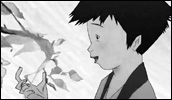Tekkon Kinkreet
- Year
- 2006
- Original title
- Tekkon Kinkrito
- Japanese title
- 鉄コン筋クリート
- Director
- Cast
- Running time
- 111 minutes
- Published
- 16 March 2008



by Paul Jackson
If you read any press surrounding Tekkon Kinkreet one fact will become abundantly clear: American Michael Arias is the first foreigner to direct an anime feature in Japan. Although significant as an industry first, this has, in some critical quarters, overshadowed discussions of the film itself - wrongly attributing its strengths and weaknesses almost exclusively to Arias's nationality. If any surprise is to be found in the choice of Arias as director, it is his professional background: Trained as a Hollywood special effects technician, Arias has little animation experience and by his own admission (in an interview with Otaku USA magazine) doesn't "have the chops to be a traditional animator."
Fortunately for him, and indeed us, Tekkon Kinkreet isn't a traditionally animated film. Adapted from Taiyo Matsumoto's manga, Tekkon Kinkreet tells of young street urchins Black and White living hand to mouth on the streets of Treasure Town, a ramshackle melange of crooked lines and dirty surfaces; fading nostalgia and intrusive modern developments. Siblings in spirit if not blood, Black and White maintain a territorial existence picking pockets and violently sparring with the local yakuza. Enter a power hungry alien, and Black and White's lives begin to crumble like the buildings that surround them.
Black and White reflect opposite sides of a shared existence, defined as much by the other as their own individuality. Attuned to an invisible sadness, White retains much of the innocence that Black has lost - in one scene, he weightlessly floats from a rooftop like a leaf caught on a warm undercurrent of air, recalling a similar moment of childhood jubilation seen in Isao Takahata's Only Yesterday (1991). Black, the older paternal figure, is fiercely protective of White, often erupting into extreme outbursts of violence. One character remarks that White would have died long ago without Black. The reverse is also certainly true.
Arias reportedly screened Fernando Meirelles' City Of God (2002) to his crew during pre-production. Unsurprisingly, the influence of Meirelles' film is evident throughout Tekkon Kinkreet. Both films place their young protagonists on the cusp of adulthood, amidst a malaise of simmering violence and hopelessness. Comparing Treasure Town to the slums of Rio de Janeiro immediately reveals that Tekkon Kinkreet is the more playful of the two, and, perhaps as a result, is ultimately less affecting. Arias is far more successful, however, in adapting City of God's camera techniques to animation. An elaborate computer generated model of Treasure Town allows Arias's camera to record the city from limitless angles. The film opens with a tracking shot of a crow in flight - the camera is exhilaratingly thrust through clouds, over a river and into the bustling city to dazzling affect. Later, White as is being chased through city streets, a POV shot records every agonizing moment of indecision, rapidly shifting from one detail to the next, as he fearfully considers his escape.
Arias and Tekkon Kinkreet have found a natural home in Studio 4ºC. The cutting edge production house is no stranger to marrying Japanese and western talents having previously produced The Animatrix (2001), a collection of short films made by an international roster of animators (including Arias himself in the role of producer). Furthermore, Studio 4ºC's commitment to emerging digital animation techniques is unparalleled, as seen in the exceptional Mind Game (2004). Arias utilizes many of the same techniques seen in Mind Game but his execution is more conventional. Here, pencil and water colour effects are used more simply to visualise White's dreams of sanctuary and Black's conflicted sub-conscious. In a marked contrast to the meticulously detailed visuals of Treasure Town, White repeatedly imagines an edenic world of rapidly blossoming greenery that fills the screen like water colours spread over a canvas. Later, following an attack by a ruthless alien, White's imaginary world seeps into Treasure Town through a stab wound in the form of a flower twisting and opening in the sunlight.
Like so many anime feature films, Tekkon Kinkreet's ending may seem too abstract for some. Similarly, Arias perilously walks the divide between style and substance. At once visually stunning and, for the most part, dramatically engaging, Tekkon Kinkreet sits just about comfortably between the two. There are certainly occasional miss-steps - sub plots rarely achieve the emotional resonance they could have and some character motivations are unfortunately lost - but Arias has crafted a debut feature that not only lives up to Studio 4ºC's reputation, but also compares favorably to the recent works of a number of much more established directors, Japanese and American alike.